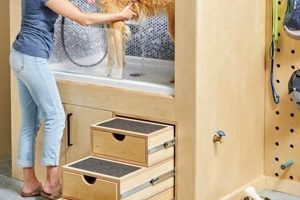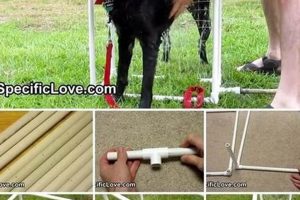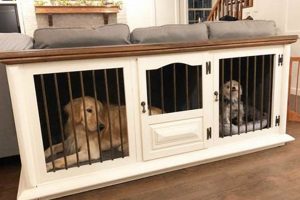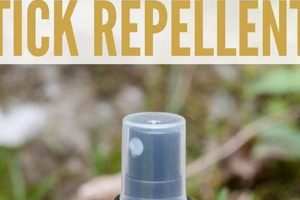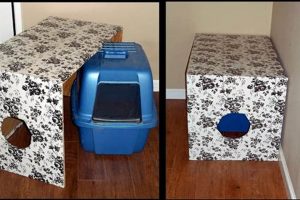Homemade playthings for canines represent a cost-effective and engaging alternative to commercially manufactured products. These items are typically created from readily available household materials, repurposed to provide entertainment and stimulation for dogs. An example includes a braided rope toy fashioned from old t-shirts or a puzzle feeder constructed from a plastic bottle.
The creation of canine enrichment items offers several advantages. It allows for customization based on a dog’s individual preferences and play style. This personalization can lead to increased engagement and reduced boredom, thereby mitigating destructive behaviors. Furthermore, utilizing recycled materials contributes to environmental sustainability. Historically, owners have fashioned such items out of necessity, but today the practice also reflects a conscious choice to provide tailored and affordable enrichment.
The subsequent sections will explore various designs, material selections, and safety considerations relevant to constructing durable and stimulating enrichment items for canine companions. Emphasis will be placed on projects suitable for different skill levels and designed to address diverse canine needs.
Construction and Usage Guidelines
The following guidelines are provided to ensure the safe and effective creation and utilization of homemade play objects for canines.
Tip 1: Material Selection. Prioritize non-toxic materials. Fabrics should be durable and resistant to tearing. Avoid small parts that could be ingested, presenting a choking hazard.
Tip 2: Structural Integrity. Reinforce seams and connections. Regular inspection for wear and tear is crucial. Discard items exhibiting damage that could pose a risk to the animal.
Tip 3: Size Appropriateness. Ensure dimensions are suitable for the dog’s breed and size. Objects that are too small may be swallowed, while excessively large items may be unwieldy and frustrating.
Tip 4: Supervised Introduction. Initially, allow interaction under direct observation. This enables assessment of the dog’s response and identification of potential safety concerns.
Tip 5: Hygiene Maintenance. Implement a regular cleaning schedule. Wash fabric items frequently to prevent bacterial growth. Disinfect plastic or rubber components with a canine-safe solution.
Tip 6: Rotation of Items. Introduce novelty by rotating available objects. This helps maintain the dog’s interest and prevents boredom-related destructive behaviors.
Tip 7: Avoidance of Harmful Items. Refrain from using hard plastic components with sharp edges or toys that could splinter. These materials can cause oral or digestive trauma.
Adhering to these guidelines contributes to the provision of stimulating and safe enrichment options for canines, fostering both physical and mental well-being.
The subsequent section will present specific design examples, illustrating the practical application of these principles.
1. Safety
The creation of homemade playthings for dogs necessitates a rigorous focus on safety. The absence of stringent quality control, inherent in commercial manufacturing, places a greater burden on the creator to ensure the well-being of the animal. Material selection represents a critical juncture. The use of toxic substances, such as paints containing lead or fabrics treated with harmful chemicals, poses a direct threat to canine health. Furthermore, small, detachable components, including buttons or loosely affixed decorations, present a significant choking hazard and potential for intestinal obstruction. A disregard for safety can lead to severe consequences, ranging from mild gastrointestinal distress to life-threatening emergencies requiring veterinary intervention. For instance, a poorly constructed rope toy can unravel, leading to the ingestion of long strands that cause intestinal blockages, necessitating surgical removal.
Construction techniques also play a pivotal role in safety. Inadequate reinforcement of seams or joints can result in rapid disintegration of the toy, exposing potentially dangerous internal materials. Sharp edges, exposed staples, or splintering wood can inflict lacerations and puncture wounds. The design of the toy should consider the dog’s chewing habits and play style. Aggressive chewers require more robust designs and durable materials to minimize the risk of breakage. For example, stuffing used in a plush toy must be securely contained to prevent ingestion, and any squeakers must be encased in a material that prevents accidental swallowing.
In summary, the integration of safety protocols is not merely an adjunct to the construction of canine play objects; it is a foundational requirement. The understanding of material properties, construction methods, and canine behavioral patterns is paramount. Neglecting these considerations undermines the purported benefits of homemade playthings and exposes animals to avoidable harm. Prudence and diligence are essential to ensure that these items serve as sources of enrichment rather than instruments of injury. The benefits derived from enrichment are negated when the potential for safety violations exists.
2. Durability
The lifespan of a homemade canine play object significantly impacts its overall value. The durability of a DIY dog toy determines its ability to withstand typical canine behaviors, such as chewing, tugging, and general wear and tear. Insufficient durability results in frequent replacements, negating the cost-saving benefits associated with the DIY approach.
- Material Resistance to Degradation
The selection of materials resistant to degradation is paramount. Natural fibers, such as cotton or hemp, offer reasonable durability but may be susceptible to tearing. Synthetic materials, such as fleece or nylon, exhibit greater resistance to tearing and abrasion but may pose health risks if ingested. The material’s ability to withstand repeated stress, moisture exposure, and UV radiation directly influences the toy’s longevity.
- Construction Integrity and Reinforcement
Construction techniques contribute significantly to overall durability. Secure seams, reinforced edges, and robust connections are essential. For sewn objects, using strong threads and multiple stitch rows strengthens vulnerable areas. Braided or knotted designs must maintain their integrity under tension. Weaknesses in construction accelerate wear and tear, leading to premature failure.
- Resistance to Canine Chewing Forces
Canine jaw strength varies significantly based on breed and individual dog. Play objects designed for powerful chewers require inherently durable materials and construction methods. Rubber or dense nylon components can withstand greater chewing forces than softer fabrics or plastics. Designs incorporating multiple layers or internal reinforcement offer enhanced resistance.
- Maintenance and Cleanability
Regular maintenance enhances the lifespan of homemade canine enrichment items. Cleanability is a critical factor. Materials that readily trap dirt, moisture, or bacteria deteriorate more rapidly. Washable fabrics and easily disinfected surfaces promote hygiene and prevent material breakdown. Regular inspection for wear and tear allows for timely repairs, extending the item’s usability.
In conclusion, the durability of a homemade canine enrichment item is a multifaceted attribute encompassing material selection, construction integrity, chewing resistance, and maintainability. Prioritizing these factors ensures that the item provides long-lasting enrichment, minimizing replacement costs and maximizing its overall value. A well-constructed, durable object offers sustained stimulation, promoting both physical and mental well-being for the canine companion.
3. Cost-effectiveness
The creation of homemade canine play objects represents a potentially significant reduction in pet-related expenditure. Commercial dog toys often carry substantial price tags, reflecting manufacturing costs, marketing expenses, and retail markups. The utilization of readily available household materials, such as discarded textiles, plastic containers, or rope remnants, substantially lowers the initial investment required to provide canine enrichment. The economic impact is particularly pronounced for owners of multiple dogs or those with dogs prone to rapid toy destruction, where the cumulative cost of commercial replacements can become considerable. For example, a single, commercially produced puzzle toy may cost upwards of $20, whereas a similar item crafted from repurposed plastic bottles and cardboard boxes incurs only the minimal expense of adhesive and supervisory time.
Further contributing to the cost-effectiveness is the potential for customization. By constructing play objects tailored to a dog’s specific preferences and play style, owners can avoid purchasing items that are quickly discarded or ignored. This targeted approach maximizes engagement and minimizes the waste of resources on unsuitable toys. Furthermore, the act of creating the toys can itself provide a form of enrichment for the owner, offering a creative outlet and strengthening the bond with the animal. The use of recycled materials also aligns with principles of environmental sustainability, reducing waste and minimizing the ecological footprint associated with pet ownership.
In summary, the financial benefits derived from constructing canine play objects from repurposed materials are multifaceted. The reduction in direct purchasing costs, the avoidance of unsuitable toy acquisitions through customization, and the incorporation of sustainable practices combine to create a cost-effective solution for canine enrichment. While initial time investment is required, the long-term economic advantages, coupled with the potential for enhanced engagement and environmental responsibility, underscore the practical significance of homemade play objects for dogs. The understanding of this connection is critical for pet owners seeking to provide enriching experiences for their companions while effectively managing their financial resources.
4. Stimulation
The provision of adequate mental and physical stimulation is a critical component of canine well-being. Homemade canine play objects, when designed and implemented thoughtfully, can serve as effective tools for enriching a dog’s environment and preventing boredom-related behavioral problems. These objects offer opportunities for engagement that surpass the inherent limitations of commercially available, mass-produced items.
- Cognitive Challenge via Puzzle Toys
Puzzle toys, designed to require problem-solving skills to access treats or rewards, present a significant cognitive challenge. A homemade puzzle toy might involve hiding treats within a series of nested containers, requiring the dog to manipulate the containers in a specific sequence to gain access. This type of activity stimulates the brain, promoting mental acuity and preventing cognitive decline. The construction of such toys allows for customization based on the dog’s intelligence level and problem-solving abilities, ensuring an appropriate level of stimulation.
- Sensory Enrichment through Varied Textures and Scents
The engagement of multiple senses enhances a dog’s environmental experience. Homemade play objects can incorporate a variety of textures, such as rough ropes, smooth fabrics, or crinkling materials, to stimulate tactile senses. Additionally, the infusion of safe and appealing scents, such as lavender or chamomile (in diluted form), can provide olfactory enrichment. The strategic combination of textures and scents can create a multi-sensory experience that promotes engagement and reduces sensory deprivation.
- Physical Activity and Exercise Promotion
Play objects that encourage physical activity contribute to overall health and well-being. Homemade fetch toys, tug-of-war ropes, or agility course components can promote exercise and burn excess energy. The design of these items should prioritize safety and durability to withstand rigorous use. Regular physical activity helps maintain a healthy weight, strengthens muscles, and improves cardiovascular health. The customized nature of such objects ensures appropriateness for the dog’s size, breed, and physical capabilities.
- Social Interaction and Bonding Enhancement
Interactive play with homemade play objects strengthens the bond between dog and owner. Activities such as fetch, tug-of-war, or hide-and-seek foster communication, trust, and cooperation. The creation of these objects can also serve as a bonding experience, as the owner dedicates time and effort to providing enrichment for the animal. The shared enjoyment of play promotes positive emotional connections and reinforces the human-animal bond.
In conclusion, the incorporation of homemade play objects into a dog’s environment can significantly enhance its overall stimulation. By providing cognitive challenges, sensory enrichment, physical activity, and opportunities for social interaction, these objects contribute to a more fulfilling and stimulating life for the canine companion. The creation and utilization of such items underscores the importance of proactive enrichment strategies in promoting canine well-being and preventing behavioral problems. This benefit is only achieved, however, with safe design, safe material use, and responsible engagement with the animal.
5. Customization
The capacity for tailoring play objects to meet the specific needs and preferences of individual canines represents a primary advantage of the do-it-yourself (DIY) approach. This contrasts sharply with the standardized nature of commercially manufactured items, which may not adequately address the unique characteristics of each animal.
- Tailoring to Breed-Specific Traits
Different canine breeds possess distinct physical and behavioral traits that influence their play styles. For example, herding breeds may benefit from toys that simulate herding behaviors, while terriers may be more inclined towards digging or chasing activities. Customization allows for the creation of toys that cater to these breed-specific instincts, maximizing engagement and reducing the likelihood of boredom or disinterest. An example might include a rolling ball for herding breeds or a durable digging box for terriers.
- Adapting to Size and Physical Ability
The size and physical capabilities of a dog significantly impact its ability to interact with a play object. Small breeds require smaller, lightweight toys that are easy to manipulate, while larger breeds necessitate more robust and durable items capable of withstanding greater force. Similarly, dogs with physical limitations, such as arthritis or mobility issues, may benefit from toys that are designed to be easily accessible and require minimal exertion. Customization enables the creation of toys that are appropriately scaled and adapted to the individual dog’s physical attributes.
- Addressing Chewing Preferences and Habits
Chewing behavior varies significantly among individual canines, ranging from gentle gnawing to aggressive destruction. Customization allows for the selection of materials and construction methods that align with a dog’s specific chewing preferences. For aggressive chewers, durable materials such as reinforced nylon or hard rubber may be necessary, while gentler chewers may be satisfied with softer fabrics or pliable plastics. The ability to tailor the toy’s construction to withstand the dog’s chewing habits prolongs its lifespan and reduces the risk of ingestion or injury.
- Incorporating Individual Preferences and Interests
Beyond breed-specific traits and physical attributes, individual dogs often exhibit unique preferences and interests that can be incorporated into play object design. Some dogs may be particularly drawn to specific textures, scents, or sounds. Customization allows for the integration of these preferred elements into the toy’s construction, enhancing its appeal and increasing the likelihood of sustained engagement. For example, a dog that enjoys crinkling sounds may be more interested in a toy filled with cellophane, while a dog that is attracted to specific scents may respond positively to a toy infused with essential oils (in a safe and diluted concentration).
In summary, the capacity for customization represents a key advantage of DIY canine play objects. By tailoring toys to align with a dog’s breed, size, physical abilities, chewing habits, and individual preferences, owners can create enrichment items that are more engaging, durable, and safe. This personalized approach maximizes the benefits of play and promotes the overall well-being of the animal.
6. Accessibility
Accessibility is a cornerstone of the value proposition associated with homemade canine play objects. The ability to create these items without specialized equipment or advanced skills significantly expands their availability to a wider population of pet owners. The utilization of common household materials, often discarded items, removes financial barriers that might otherwise limit access to commercial alternatives. This democratization of canine enrichment is particularly relevant for individuals with limited financial resources or those residing in areas with restricted access to pet supply retailers. The cause-and-effect relationship is direct: increased material availability and simplified construction processes lead to enhanced access for a broader segment of pet owners.
The importance of accessibility extends beyond mere economic considerations. The ease of construction enables pet owners to respond promptly to their animal’s needs and preferences, without the delays associated with purchasing and delivery. For example, an owner observing signs of boredom can quickly fashion a stimulating puzzle toy from a cardboard box and some treats. This responsiveness contributes to a more enriched and fulfilling life for the animal. Furthermore, the accessibility of these projects encourages pet owners to actively engage in their animal’s welfare, fostering a stronger bond and promoting responsible pet ownership. Practical applications include creating toys suited for disabled pets with limited mobility or designing enrichment activities based on materials found in specific environmental contexts.
In summary, the accessibility of homemade canine play objects represents a critical component of their overall appeal and effectiveness. This attribute lowers economic and logistical barriers, enabling a larger number of pet owners to provide enriching experiences for their animals. While challenges related to ensuring safety and durability remain, the inherent accessibility of this approach positions it as a valuable tool for promoting canine welfare and responsible pet ownership.
Frequently Asked Questions Regarding DIY Dog Toys
The following section addresses common inquiries and misconceptions surrounding the construction and utilization of homemade play objects for canine companions.
Question 1: What are the primary risks associated with homemade play objects for dogs?
The primary risks involve material toxicity, choking hazards from small parts, and lacerations or punctures from sharp edges or splinters. Vigilant material selection and robust construction techniques are essential to mitigate these risks.
Question 2: How can the durability of homemade play objects be maximized?
Durability is enhanced through the utilization of robust materials, reinforced seams and connections, and designs that withstand the dog’s chewing habits. Regular inspection and maintenance are also crucial.
Question 3: Are all household materials suitable for constructing canine play objects?
No. Materials such as hard plastics, small rubber bands, and textiles containing harmful dyes should be strictly avoided. Non-toxic, durable materials are paramount.
Question 4: How often should homemade play objects be inspected for wear and tear?
Play objects should be inspected daily, particularly those subjected to heavy chewing or rough play. Any signs of damage necessitate immediate repair or disposal.
Question 5: Can homemade play objects effectively address behavioral issues in dogs?
When designed to provide adequate mental and physical stimulation, homemade play objects can help mitigate boredom-related behavioral problems. However, they should not be considered a substitute for professional behavioral training when necessary.
Question 6: What are the legal considerations regarding the creation and distribution of homemade canine play objects?
While creating toys for personal use carries minimal legal risk, selling or distributing these items may subject the creator to product liability laws. Compliance with safety standards and appropriate labeling are essential.
The information provided addresses key concerns related to the safety, durability, and responsible use of homemade canine enrichment items.
The subsequent section will explore specific design examples, illustrating the practical application of these principles.
Conclusion
This exploration of diy dog toy construction has highlighted key aspects influencing their value and efficacy. Emphasis has been placed on safety, durability, cost-effectiveness, stimulation, customization, and accessibility. These attributes, when properly considered, transform readily available materials into engaging and beneficial enrichment items for canine companions.
The responsible creation and utilization of diy dog toy necessitate a commitment to safety and an understanding of canine behavior. As pet ownership evolves, the importance of customized and enriching environments for animals will continue to grow, potentially fueling innovation and awareness in the field of homemade enrichment. Prioritizing safety and engaging responsibly with animal companions remains paramount.


